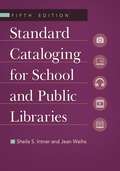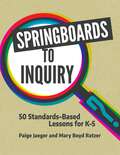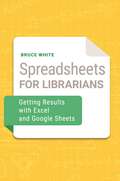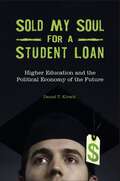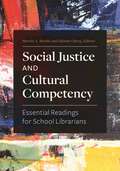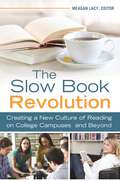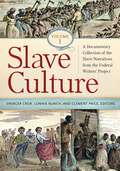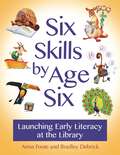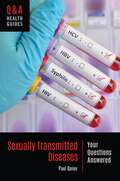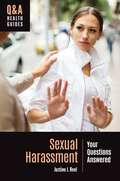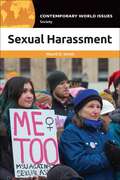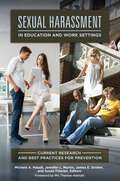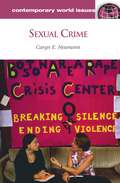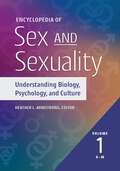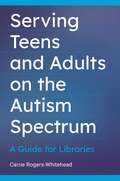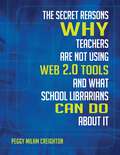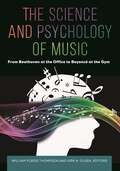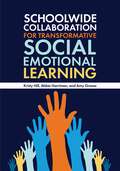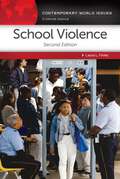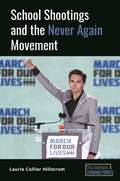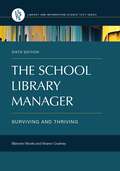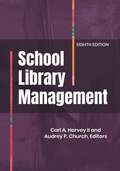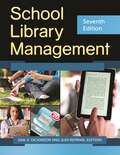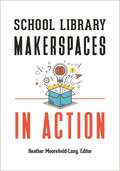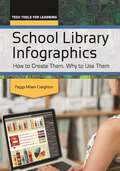- Table View
- List View
Standard Cataloging for School and Public Libraries
by Sheila S. Intner Jean WeihsA proven resource for librarians and students, this updated classic opens the door to understanding current library cataloging processes, shows you how to use them to create standard catalog records, and provides guidance in managing the cataloging workflow.Library cataloging and classification tools are constantly improving, making this concise guide a necessity for any librarian or library student seeking improved understanding of the practical process of cataloging today. With the release of RDA, a new code for description, and a new edition of Dewey Classification, it's time for every library to add this fifth edition of a classic reference to your resources. Two Margaret Mann Citation winners update you on the five basic steps in standardized library cataloging: describing and adding access points for resources; assigning subject headings using Sears List or Library of Congress subject headings; classifying them using the Dewey Decimal or Library of Congress classification systems; and digitizing the resulting records.The book opens with a brief look at the environment in which cataloging now functions, especially in response to advances in digital access. It clarifies terminology, explores new and changed applications, and enhances understanding of basic principles for those responsible for creating cataloging data. To get you ready for tomorrow, the edition closes with a brief look at trends likely to affect cataloging in the foreseeable future.
Springboards to Inquiry: 50 Standards-Based Lessons for K-5
by Paige Jaeger Mary Boyd RatzerThis collection of ideas for lessons provides school librarians with inspiration for meeting the tsunami of new standards dictating change for today's next generation learners.Today's school librarian has less and less time to prepare for instruction. This book delivers lesson plans for the librarian to implement immediately, as is or with a little adaptation. Using the new AASL standards and an Information Literacy scope and sequence carefully crafted for K–6 students, the authors package lessons that are both engaging and challenging.This book inspires librarians to go beyond their usual role in literacy promotion and instruction only and moves to preparing students to be inquiry learners by embracing inquiry-based learning. Lessons include the Essential Question (begin with the end in mind); pre- and post-assessment ideas; technology integration ideas, where applicable; reading and research ideas; and collaboration ideas when applicable. AASL Standards and others are noted via an "integrated standards checklist," while new educational research demonstrates that standards can be met via engaging, collaborative, and interesting lessons, modeled throughout the text.
Spreadsheets for Librarians: Getting Results with Excel and Google Sheets
by Bruce WhiteWork smarter and save time with the librarian's guide to the hidden-in-plain-sight secrets of Excel, Sheets, and other types of spreadsheets.While some librarians have become very skilled at using the full power of Excel and Sheets to turn data into useful and valuable information, for many librarians the relevance of spreadsheets—and how to use them—is not necessarily obvious.This book demystifies Excel and other spreadsheets. Starting from basic concepts, the book progresses to advanced implementations important to librarians in such areas as collection management, including evaluation and benchmarking; research assessment through the creation of sophisticated bibliometric measures; and library design based on an analysis of patron behavior or the creation of a keyword map of physical collections. Real-life examples highlight a variety of techniques and shortcuts that can be immediately applied to libraries of all kinds.Spreadsheets for Librarians is a book for the desk, not only the library shelves. No prior knowledge of spreadsheets is needed, and readers can expect to learn skills that will enhance their reputation as information and data professionals.
Sold My Soul for a Student Loan: Higher Education and the Political Economy of the Future
by Daniel T. KirschWith unprecedented student debt keeping an entire generation from realizing the "American Dream," this book sounds a warning about how that debt may undermine both higher education—and our democracy.American higher education boasts one of the most impressive legacies in the world, but the price of admission for many is now endless debt. As this book shows, increasing educational indebtedness undermines the real value of higher education in our democracy. To help readers understand this dilemma, the book examines how student debt became commonplace and what the long-term effects of such an ongoing reality might be. Sold My Soul for a Student Loan examines this vitally important issue from an unprecedented diversity of perspectives, focusing on the fact that student debt is hindering the ability of millions of people to enter the job market, the housing market, the consumer economy, and the political process.Among other topics, the book covers the history of consumer debt in the United States, the history of federal policy toward higher education, and political action in response to the issue of student debt. Perhaps most importantly, it explores the new relationship debtor-citizens have to the government as a result of debt, and how that impacts democracy for a new generation.
Social Justice and Cultural Competency: Essential Readings for School Librarians
by Marcia A. Mardis and Dianne Oberg, EditorsPublished in partnership with the International Association of School Librarianship, this work gathers together the latest and most important research on the topics of social justice and cultural competency in school libraries.Education systems today are expected to advance national goals related to fairness, equity, and social cohesion. Comprising articles written and collected in the journal of the International Association of School Librarianship and new articles written especially for this anthology, this book documents both empirical research and promising practices to help school librarians and teachers work together to promote social justice and develop learners' and educators' cultural competence.Both coeditors are experienced in working with authors from around the world and have participated in the development of effective and ethical standards and guidelines for school library practitioners. Brief real-life case studies of school librarians and teachers in action showcase efforts to improve the lives of marginalized or under-served students. School librarians inside and outside of the United States, school library educators and policymakers, and academic librarians building school librarianship collections will find this guide valuable.
The Slow Book Revolution: Creating a New Culture of Reading on College Campuses and Beyond
by Meagan LacyThis inspiring guide shows how to implement the principles of the Slow Book movement in college campus libraries as well as public and high school libraries, with the ultimate goals of encouraging pensive reading habits and creating a lifelong enjoyment of books.In a world of constant Facebook posts and Tweets, digital distractions and online reading habits are wearing at students' ability to focus, reflect, synthesize, and think deeply. This professional text, based on a concept introduced by Maura Kelly in the online edition of The Atlantic, delves into the trend toward contemplative reading—otherwise known as the Slow Book movement—explaining what it is, why it's important, and how you can implement it in various ways and in multiple settings.Author and librarian Meagan Lacy, along with contributions from others in the field, offers insights, advice, and practical tools to help you foster an appreciation of reading in students both during and after college. The first part of the book establishes the importance of the Slow Book movement, while the second and third sections combine case studies and guidance for employing the principles of this method across multiple genres, including fiction, nonfiction, classics, and contemporary works. Chapters build a rationale for the approach, describe its underlying philosophy, and articulate concrete ways to apply the methodology in different venues.
Slave Culture [3 volumes]: A Documentary Collection of the Slave Narratives from the Federal Writers' Project [3 volumes]
by Spencer Crew Lonnie Bunch Clement PriceFor the first time, the WPA Slave Narratives are organized by theme, making it easier to examine—and understand—specific aspects of slave life and culture.There is no better way to appreciate history than to experience it through the eyes of those who lived it. Slave Culture: A Documentary Collection of the Slave Narratives from the Federal Writers' Project brings together the memories of the last generation of enslaved African Americans gathered through interviews conducted between 1936 and 1938. This three-volume work stands apart from previous Slave Narrative collections in that it organizes the narratives thematically, bringing the rich tapestry of slave culture to life in a fresh way. Within each thematic area, multiple excerpts span time, gender, and geography. An introductory essay for each theme and a contextual explanation for each narrative help readers draw lessons from this vast collection, while an introduction to the work explains the Works Progress Administration's Slave Narrative project—illuminating still another era in American history.
Six Skills by Age Six: Launching Early Literacy at the Library
by Anna Foote Bradley DebrickThis one-stop guide to nurturing six core early literacy skills at your library also offers practical tips for sharing these skills with parents, teachers, and other caregivers so they can institute them in playgroups, in school, or at home.Though libraries have been presenting early literacy activities for decades, library staff may lack an in-depth understanding of early literacy skills and their place in preparing children for a lifetime of learning. Based on the program "6 by 6: Ready to Read," this book is chock full of practical, everyday ideas on how you can foster the six core early literacy skills children should ideally acquire by age six. The volume begins by introducing the importance of early literacy and explaining how to start or expand an early literacy program in your library, regardless of its size. Subsequent chapters explore the six core skills and offer suggestions on how to showcase them in library programs and services. The book also includes activities that relate to each skill, suggests books that are especially useful in exploring each skill, and tells you how to create early literacy spaces. Three sets of storytime plans—one each for babies, toddlers, and preschoolers—are presented as well. Written primarily for public librarians and library staff, this guide will also be informative for parents and for educators who work with young girls and boys.
Sexually Transmitted Diseases: Your Questions Answered (Q&A Health Guides)
by Paul QuinnThis valuable book provides a delicate introduction to the topic of sexually transmitted diseases (STDs), especially as they relate to teens and young adults.Sexually transmitted diseases (STDs) are on the rise globally, despite advances in science, technology, and the pharmaceutical industry. Individuals may not realize they have an STD or may be reluctant to get tested or seek treatment because of the stigma surrounding such conditions. This title in Greenwood's Q&A Health Guides series, Sexually Transmitted Diseases: Your Questions Answered provides clear, concise information for readers who want to learn more about and safeguard their sexual health. In addition to in-depth discussion of all STDs, it covers topics such as prevention, testing, disclosure with partners, and potential long-term consequences.Each book in this series follows a reader-friendly question-and-answer format that anticipates readers' needs and concerns. Prevalent myths and misconceptions are identified and dispelled, and a collection of case studies illustrates key concepts and issues through relatable stories and insightful recommendations. The book also includes a section on health literacy, equipping teens and young adults with practical tools and strategies for finding, evaluating, and using credible sources of health information both on and off the internet—important skills that contribute to a lifetime of healthy decision-making.
Sexual Harassment: Your Questions Answered (Q&A Health Guides)
by Justine J. ReelThis book answers readers' most pressing questions about sexual harassment, including how to identify it, its causes, and its effects. It also provides guidance and resources for anyone experiencing or witnessing sexual harassment.Unfortunately, sexual harassment is an all-too-common reality for many women and men. But what exactly constitutes sexual harassment, and how is it different from assault, bullying, and other forms of unwanted attention? Why is sexual harassment so common? How can being sexually harassed impact an individual's academic or work performance, psychological well-being, and even physical health? What can you do if you experience sexual harassment or believe someone else is experiencing it?Books in Greenwood's Q&A Health Guides series follow a reader-friendly question-and-answer format that anticipates readers' needs and concerns. Prevalent myths and misconceptions are identified and dispelled, and a collection of case studies illustrates key concepts and issues through relatable stories and insightful recommendations. Each book also includes a section on health literacy, equipping teens and young adults with practical tools and strategies for finding, evaluating, and using credible sources of health information both on and off the internet—important skills that contribute to a lifetime of healthy decision-making.
Sexual Harassment: A Reference Handbook (Contemporary World Issues)
by Merril D. SmithProviding an indispensable resource for students investigating sexual harassment in the United States, Sexual Harassment: A Reference Handbook is a comprehensive summary of history, current events, possible solutions, and resources.Sexual Harassment: A Reference Handbook provides readers with a comprehensive overview of the topic and connected issues. In addition to discussing the background and history of sexual harassment, it analyzes related problems and controversies and gives possible solutions. It also provides additional perspectives on sexual harassment by contributors and sketches of people and organizations, as well as documents, resources, and a timeline.This volume covers workplace harassment; street harassment; harassment in schools, the military, and prisons; and cyber harassment. The format gives readers a well-balanced perspective on this timely topic with multiple viewpoints showcased in essays by contributors who have experienced sexual harassment, adding depth and relevance. The volume discusses the history of sexual harassment and brings the topic to the present day, and additionally covers recent events and people who have been in the news while putting them in context. Readers can see how laws and awareness of sexual harassment have changed. Additional resources are provided to guide those who wish to further investigate the topic.
Sexual Harassment in Education and Work Settings: Current Research and Best Practices for Prevention (Women's Psychology)
by Michele A. Paludi, Jennifer L. Martin, James E. Gruber, and Susan FineranAddresses current legal and psychological issues involved in campus and workplace violence, specifically sexual misconduct, and offers best practices for organizations seeking to prevent and respond to sexual misconduct.Based on an idea conceived at a conference for the International Coalition of Sexual Harassment, this book offers up-to-date information about sexual harassment and other forms of sexual misconduct in academic and workplace settings, as well as legal and guidance updates and best practices that discuss prevention methods. The chapters are written by noted attorneys, campus and workplace consultants, and other scholars who have assisted in collecting incident data and have thought leadership to offer.Chapters address how workplaces and campuses respond to forms of violence as well as the impact of sexual harassment on individuals, bystanders, and organizations. Readers will learn about topics such as the "Not Alone" initiative—a result of President Obama's Task Force to Protect Students from Sexual Assault—and the history of Titles VII and IX legislation the United States. The editors have compiled resources that address the cultural and social views of sexual harassment, the history of sexual misconduct on campuses and in organizations, and sample organizations at the national level that deal with prevention, advocacy, and legal guidance for students and employees.
Sexual Crime: A Reference Handbook (Contemporary World Issues)
by Caryn E. NeumannA contemporary, fact-filled resource on the historical, legal, medical, and political aspects of a wide variety of sexual crimes.Authoritative and informative, Sexual Crime: A Reference Handbook offers a thoroughly up-to-date report on an issue of extraordinary urgency. It is an expert introduction to a variety of often misunderstood crimes.Sexual Crime begins with a background chapter outlining the causes and definitions of sexual crime, legal and cultural attitudes over the past three centuries, and common myths surrounding this sensitive subject. It then offers wide ranging coverage of issues, including date rape, crimes involving male victims, rape in prison, female perpetrators, medical treatments, political ramifications, and other contemporary issues.
Encyclopedia of Sex and Sexuality [2 volumes]: Understanding Biology, Psychology, and Culture [2 volumes]
by Heather L. ArmstrongProviding a comprehensive framework for the broad subject of human sexuality, this two-volume set offers a context of historical development, scientific discovery, and sociopolitical and sociocultural movements.The broad topic of sex—encompassing subjects as varied as sexuality, sexual and gender identity, abortion, and such crimes as sexual assault—is one of the most controversial in American society today. This two-volume encyclopedic set provides readers with more than 450 entries on the subject, offering a comprehensive overview of major sexuality issues in American and global culture.Themes that run throughout the volumes include sexual health and reproduction, sexual identity and orientation, sexual behaviors and expression, the history of sex and sexology, and sex and society. Entries cover a breadth of subjects, such as the major contributors to the field of sexology; the biological, psychological, and cultural dimensions of sex and sexuality; and how the modern-day political climate and the government play a major role in determining attitudes and beliefs about sex. Written in clear, jargon-free language, this set is ideal for students as well as general readers.
Serving Teens and Adults on the Autism Spectrum: A Guide for Libraries
by Carrie Rogers-WhiteheadUnderstand the unique needs of teens and adults with autism and how to adapt existing library programs to be more inclusive.Autism spectrum disorder is a lifelong condition, but programs and services are mostly for children. As this population ages and the number of adults receiving autism diagnoses grows, are public libraries serving this group? Serving Teens and Adults on the Autism Spectrum offers practical strategies for delivering better service to individuals with autism, from library programming to technology, collections, library volunteers, and the information desk. Relying on feedback and help from the autism community in her area, Carrie Rogers-Whitehead created programs for children, teens, and young adults on the autism spectrum. In this book, she shares advice on developing programs that focus on teamwork, transitions, and social skills. She explains best practices for reference interviews and teaches readers how their libraries can partner with nonprofit and government entities to develop workforce skills and connect adults with autism to jobs. Ready-made program activities for teens and adults with autism make it easy for libraries to better serve this often misunderstood group.
The Secret Reasons Why Teachers Are Not Using Web 2.0 Tools and What School Librarians Can Do about It
by Peggy Milam Ph.D.School librarians need a simple action plan for overcoming the barriers to adopting School Library 2.0. This book provides one, and describes how fully integrating technology would dramatically benefit 21st-century schools.Web 2.0 and its associated tools have the power to substantially increase student achievement. This book has two straightforward primary purposes: to detail the research-based reasons classroom teachers fail to incorporate Web 2.0 tools into their instruction and collaboration with other educators; and to provide actionable strategies to rectify these omissions. The Secret Reasons Why Teachers Are Not Using Web 2.0 Tools and What School Librarians Can Do about It provides authoritative definitions of Web 2.0, explains the types of Web 2.0 tools suited for use in educational settings, examines the research-based reasons they are underutilized, and offers strategies for school librarians to model the use of technology-enabled tools—and for teaching others to do so. This book will benefit anyone wishing to effect a positive social change in improving student achievement: practicing K–12 librarians and educators, K–12 school and district administrators, and researchers in the field of K–12 education.
The Science and Psychology of Music: From Beethoven at the Office to Beyoncé at the Gym
by William Forde Thompson and Kirk N. OlsenThis book provides a broad introduction to the scientific and psychological study of music, exploring how music is processed by our brains, affects us emotionally, shapes our personal and cultural identities, and can be used in therapeutic and educational contexts.Why are some people tone deaf and others musical savants? What do our musical preferences say about our personality and the culture in which we were raised? Why do certain songs remind us so strongly of particular people, places, or events? How can music be therapeutically used to help those with autism, Parkinson's, and other medical conditions? The Science and Psychology of Music: From Beethoven at the Office to Beyoncé at the Gym answers these and other questions.This book provides a broad and accessible introduction to the fascinating field of music psychology. Despite its name, music psychology includes a number of fields, including neuroscience, psychology, social psychology, sociology, and health. Through a collection of thematically organized chapters, readers will discover how our brains recognize elements of music, how music can affect us and shape our identities, and the many real-world applications for such information.
Schoolwide Collaboration for Transformative Social Emotional Learning
by Kristy Hill Abbie Harriman Amy GrossoSchools and libraries can make a difference by teaching kids how to identify and cope with emotions, how to communicate with confidence and empathy, and how to persevere even when things are difficult.The authors of this helpful text define transformative social-emotional learning and its impact on students and schools. They present current brain research to support social-emotional programming in a whole school program with collaborative lesson ideas adaptable to all age levels for the use of counselors, librarians, administrators, classroom teachers, and all special area teachers. All lessons provide lists of extended student and faculty readings.Illustrating and highlighting how social-emotional programming helps foster and transform the culture of a school to one of belonging and acceptance, the authors also provide necessary application lessons for all educators in all areas of a school, including ideas for such common areas as playgrounds, cafeterias, classrooms, and libraries, and even ideas for implementation by school administrators.Research cited predicts desired outcomes, including a culture of belonging, increased student engagement and achievement, and a more compassionate school staff. Ideas and activities provided for professional development for educators benefit students and staff alike.
School Violence: A Reference Handbook (Contemporary World Issues)
by Laura L. FinleyA timely investigation of the history, legislation, and perpetrators of school violence, this guide debunks the myths and misconceptions about this terrible problem of national concern.With school violence on the rise, schools have implemented security safeguards like never before in the form of metal detectors, video cameras, and armed guards. School communities have mixed opinions regarding these drastic prevention measures—many welcome the protection, while some condemn the reminders of violence these tactics evoke. This comprehensive text introduces the history of school violence in the United States, providing an overview of proposed causes—from violent video games, to inadequate parental involvement, to bullying by classmates—and detailing the pros and cons of various deterrents.Experienced criminologist Laura Finley incorporates personal reflections, primary source data, and profiles of key figures to address the painful reality of school shootings and other violent acts. The text expounds upon the characteristics of victims, individuals who are most likely to carry out violence, and common types of assaults. Chapters include a discussion on current legislation; stories of infamous perpetrators; activists who are working to make schools safer; and school, community, and societal risk factors.
School Shootings and the Never Again Movement (21st-Century Turning Points)
by Laurie Collier HillstromThis volume provides a concise but authoritative overview of the Never Again Movement, which arose in the aftermath of a mass shooting that killed 17 people at a high school in Parkland, Florida, in February 2018.This volume in the 21st Century Turning Points series, a one-stop resource for understanding the people and events changing America today, analyzes school shootings and examines the broader issue of gun violence in America. It focuses on the history of school shootings in the United States and the debate that has raged for decades between gun control advocates and supporters of gun ownership rights. School Shootings and the Never Again Movement: 21st Century Turning Points provides a broad perspective on these issues. It recounts the evolution of gun politics and policy throughout the twentieth century, explains the positions and activities of organizations and activists on both sides of the gun debate, details notorious school shootings ranging from Columbine to Parkland, and explores the potential impact of the Never Again Movement on American gun policy at the state and federal levels.
The School Library Manager: Surviving and Thriving (Library and Information Science Text Series)
by Blanche Woolls Sharon CoatneyThis sixth edition of Library Unlimited's classic school library management text describes new approaches to management and addresses the realities that school librarians face in today's quickly evolving information-based world.In recent years, nearly all school libraries and school librarians have been targeted for having their funding or staffing cut as a result of reductions in school budgets. How does a newly graduated LIS professional prepare for a career in this volatile environment? How do established librarians and administrators prove their value and necessity to decision makers?This freshly updated edition of The School Library Manager is an invaluable textbook that leads readers through the many essential management tasks and skills required to administer the successful school library program and beyond. It promotes the leadership role of the school librarian in the school and addresses the need for school librarians to provide students with equal access to information. The information presented will not only enable librarians to keep their jobs but also supply specific guidance and inspiration that gives readers the ability to make their positions and libraries undeniably relevant and valuable—and to ensure a path of upward mobility in their LIS careers.
School Library Management
by Carl A. Harvey II and Audrey P. Church, EditorsHighlighting activities and discussion questions that will pique student interest and facilitate instruction, the 8th edition of this well-known school library text gathers management articles into a ready-to-use volume that showcases current best practices.This 8th edition of School Library Management offers a fully updated collection of articles designed to guide both new and practicing school librarians. It gathers information about the issues and trends in the field, programming ideas, and advice from school library leaders. Contemporary articles from the past five years of School Library Connection bring this edition up to the present.Carefully curated chapters address today's best practices to improve school library programs, integrating technology considerations throughout each of the sections. Authors cover timely topics such as equity, diversity, and inclusion; budgets; copyright; librarian professional development; evaluation; and advocacy. Each chapter begins with an introduction to put issues into context and ends with activities that will help librarians further explore.All readers will appreciate this volume as "one-stop shopping" for readings that address best practices in light of major new guiding documents and standards in the school library field.
School Library Management
by Judi Repman Gail K. DickinsonThis book compiles selected articles from Library Media Connection to help school librarians and pre-service librarians learn about how to implement best practices for school library management.At a time when budget cuts threaten the role of the school librarian, dynamic learning experiences can resurrect the usefulness of the library and the role of its staff. The seventh edition of this popular book helps librarians develop engaging school library programs for greater student involvement.Comprised of important articles from Library Media Connection (LMC), School Library Management: Seventh Edition is a compilation of best practices in the field of school library management. An excellent textbook for professors teaching LIS courses, the book contains updates to standards and technologies, and features the latest initiatives guiding practices, including Standards for the 21st Century Learner and Empowering Learners: Guidelines for School Library Programs. Each of the book's five sections features helpful tips from LMC and lists relevant resources for school library management. Selected articles address standards, inquiry, ethics, and information literacy. The book also includes a focus on the role of the school librarian in designing authentic assessments.
School Library Makerspaces in Action
by Heather Moorefield-LangMaker learning spaces in schools and public libraries are made real through the narratives of professional librarians around the world, comprising the collaborative activities, experiences, and perspectives of librarians as they have implemented makerspaces for students of all ages.School Library Makerspaces in Action is for any librarian looking for inspiration for their own makerspaces, hackerspaces, fablabs, or DIY locations and how to use these spaces in libraries and educational settings. Contributions from authors around the world address the needs of most all readers, including how to provide the staff training necessary for a successful makerspace. Each chapter is written from an author's personal experience, and with only a little fine-tuning and imagination, many of these ideas can be used throughout all levels, disciplines, and subjects in K–12 education and carry over into higher education. The successes and optimism shared in this collection will inspire librarians and educators to think positively about how to implement maker learning locations, train staff, and use makerspaces in their libraries and classrooms to promote and share new ideas.
School Library Infographics: How to Create Them, Why to Use Them (Tech Tools for Learning)
by Peggy Milam Ph.D.Find out how you can increase the impact of your school library instruction, promotion, and organization with the utilization of infographics created with do-it-yourself tips found within this guidebook.Infographics have become increasingly popular educational tools for visually conveying ideas and information—in class projects, in daily lessons, and for promoting school and library programs. This book—the only one of its kind—helps you create your own computer-generated visuals for your class and library using common software platforms and free web-based applications. A perfect primer for educators with little or no technological savvy, this resource features charts, tables, screenshots, bars, and graphs for making infographics easy to reproduce and create. Author Peggy Milam Creighton discusses the benefits of utilizing visuals with students and provides tips and strategies for creating your own graphics for various educational settings. The reference is organized into three topics: how to create infographics with Microsoft software such as Word, Excel, and PowerPoint; how to use graphics to support school library programs; and why using these visual-based learning tools is important. The work features easy-to-use tutorials, lesson plans, and project ideas for students.
